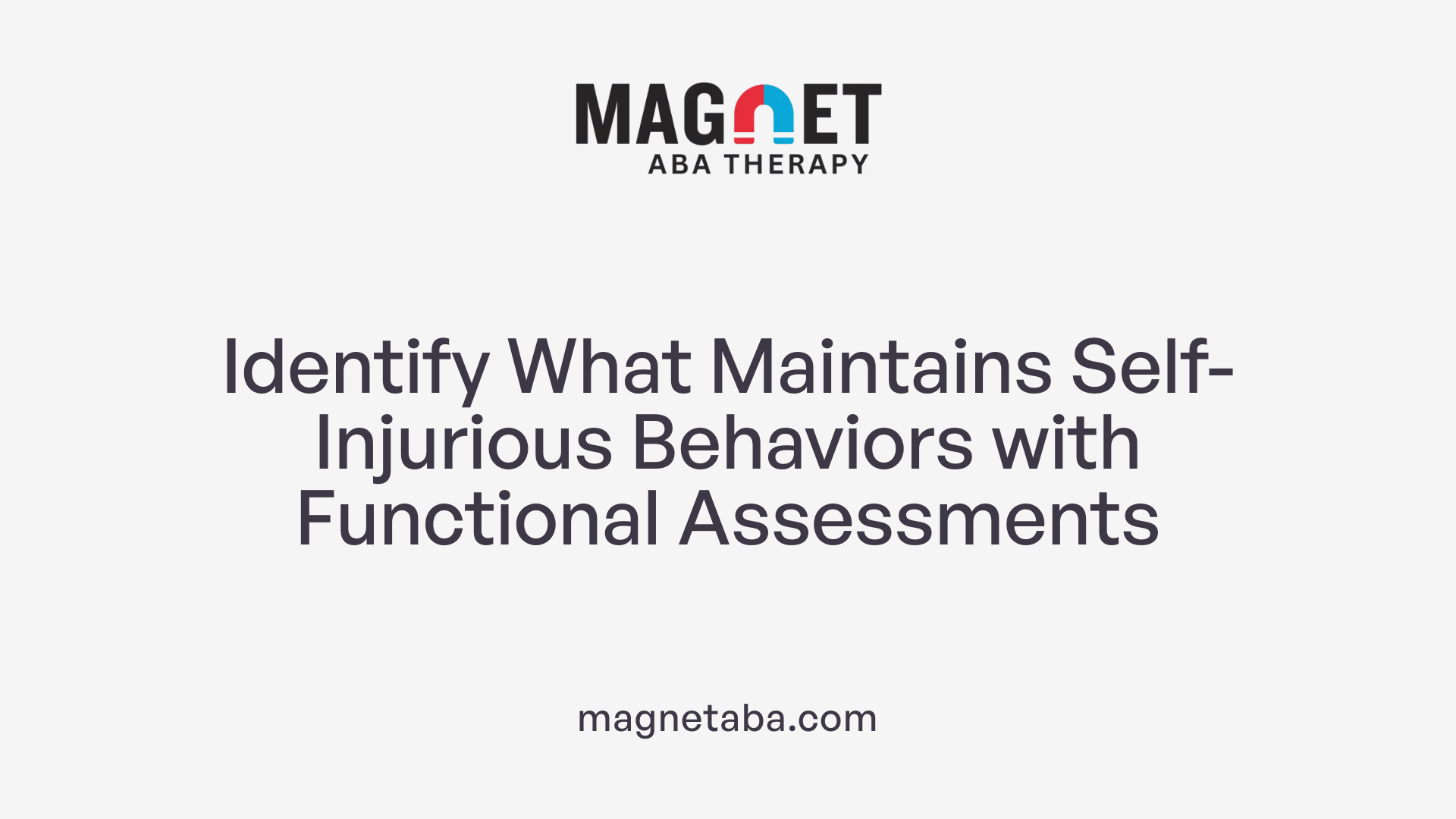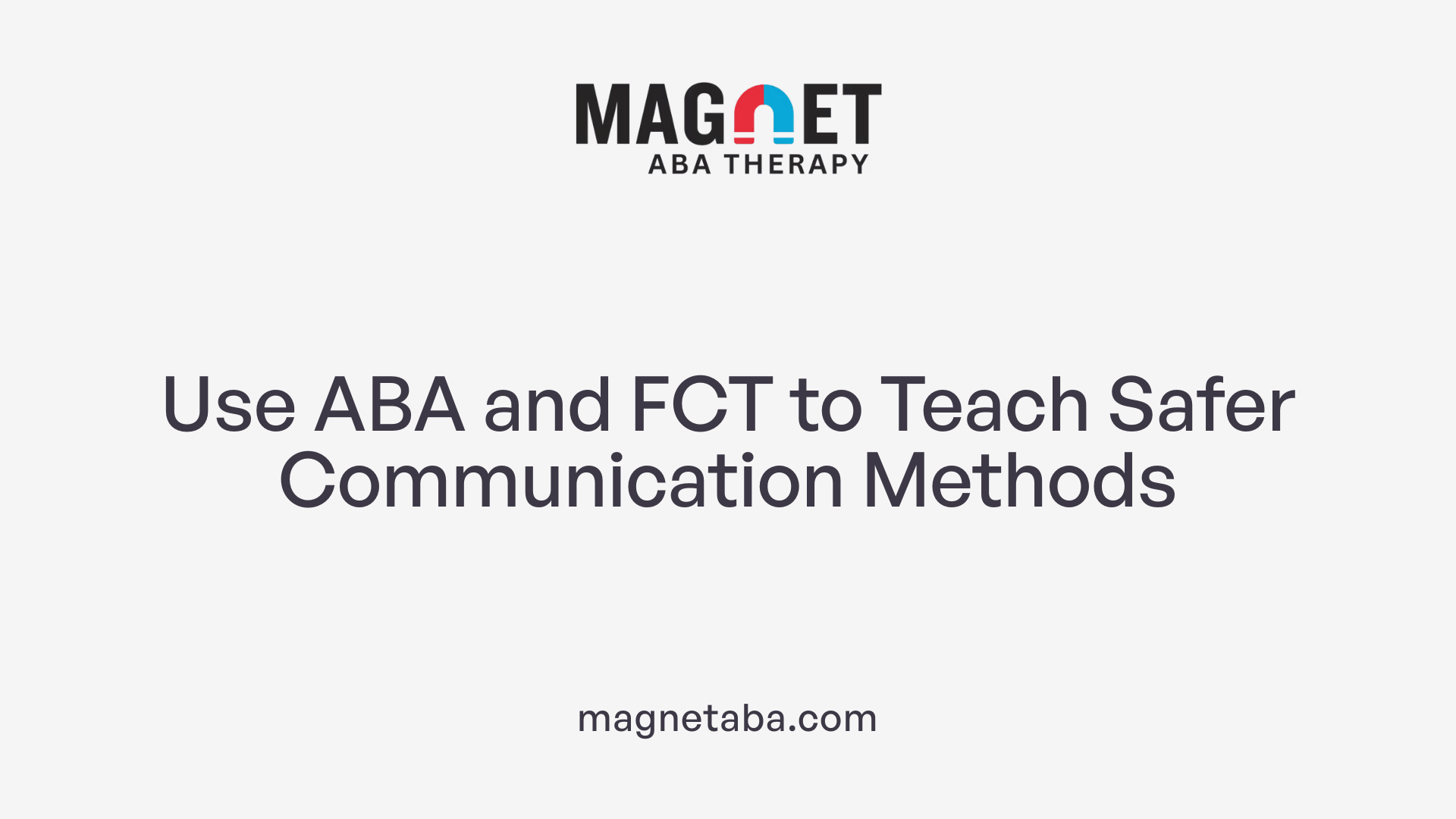Understanding Self-Injurious Behavior and the Role of ABA
Self-injurious behavior (SIB) presents a serious challenge for individuals with autism, affecting their health, safety, and quality of life. Common forms include head banging, biting, and skin-picking, which can lead to severe injuries or infections. To address this, Applied Behavior Analysis (ABA) offers evidence-based methods tailored to the functions and causes of these behaviors. This article explores how ABA can reduce self-injurious behaviors through assessment, intervention planning, and practical strategies, emphasizing a comprehensive, individualized approach.
Understanding the Causes of Self-Injurious Behaviors

What are the main reasons behind self-injurious behavior (SIB) in individuals with autism?
Self-injurious behaviors are quite common among people with autism, especially those with additional intellectual disabilities. These behaviors include head-banging, biting, scratching, skin-picking, and other acts that can cause physical harm.
The causes of SIB in autism are varied and complex. They often stem from unmet needs or feelings of frustration. For some, SIB acts as a way to communicate when verbal skills are limited or absent. Others may engage in self-injury to seek sensory stimulation or to provide relief from discomfort or pain.
Environmental factors play a significant role as well. For instance, being told off, experiencing bullying, hearing arguments, or feeling unwell can trigger self-injury. Memories of past trauma or abuse can also contribute to these behaviors.
Understanding the specific reasons in each individual case requires careful assessment, often through behavioral analysis. Once the underlying causes are identified, targeted interventions can be planned.
What about physical discomfort, communication difficulties, and sensory factors?
Physical health issues are a significant contributor to SIB. Pain, illness, or involuntary movements such as seizures may lead an individual to self-injure as a way of coping or signaling distress.
Communication challenges are another major factor. When individuals cannot effectively express their needs or discomforts, they may resort to self-injury as an alternative form of communication.
Sensory factors also influence SIB. Some individuals seek specific sensory input, like the sensation of head-banging or skin rubbing, which can be self-reinforcing. Conversely, sensory overload from bright lights, loud noises, or overwhelming environments can trigger self-injury as a means of self-regulation.
How do psychological factors like anxiety and depression influence self-injurious behavior?
Psychological states such as anxiety, depression, or stress can significantly increase the likelihood of self-injurious actions. For many, SIB serves as a coping mechanism to manage overwhelming emotions or to provide sensory relief.
Individuals experiencing high levels of anxiety or depression may have difficulty regulating their emotions. Self-injury can temporarily reduce feelings of distress, making it a maladaptive but understandable response.
Addressing these psychological influences often involves behavioral therapy, emotional regulation strategies, and sometimes medication. Creating a supportive environment that reduces stressors and teaches adaptive coping skills can greatly decrease self-injury.
How is self-injurious behavior typically treated?
Treatment for SIB is tailored to the individual and involves understanding the behavior's function. Behavioral interventions are the first line of treatment, especially those based on functional analysis, like Functional Communication Training (FCT). FCT teaches alternative, appropriate ways to communicate needs, reducing the motivation for self-injury.
Interventions also include environmental modifications—such as making routines predictable with social stories and priming—to reduce triggers.
Reinforcing positive behaviors, providing sensory alternatives, and managing medical or psychological conditions are all part of a comprehensive treatment plan.
In cases where behavioral interventions alone are insufficient, medications like risperidone or aripiprazole may be used, particularly to manage irritability and severe SIB. The choice of medication depends on the underlying causes and the specific behavioral functions.
How can self-injurious behavior be redirected effectively?
Effective redirection begins with calm, quick responses that do not unintentionally reinforce the SIB. Using visual cues, like picture symbols or communication boards, helps teach individuals appropriate ways to express their needs.
Reinforcing these alternatives immediately with praise or rewards encourages positive communication.
Providing sensory activities or tools that meet the individual's needs can prevent triggers. For example, fidget toys or calming strategies such as deep-pressure input can reduce the urge to self-injure.
Reducing demands, removing physical discomforts, and creating a predictable routine all contribute to a safer environment.
Ultimately, understanding the individual’s reasons for self-injury guides the development of tailored strategies that promote safer behaviors and improve overall well-being.
| Aspect | Description | Additional Details |
|---|---|---|
| Causes | Communication difficulties, unmet needs, sensory seeking, medical issues, emotional distress | Can include pain, frustration, trauma, or sensory overload |
| Typical Behaviors | Head-banging, biting, skin picking, hitting, scratching | Varies greatly among individuals |
| Treatment Approaches | Behavioral interventions, medical management, environmental adjustments | Based on function and individual needs |
| Behavioral Strategies | Functional communication training, reinforcement, extinction, environmental changes | Focus on replacing SIB with appropriate responses |
| Medication Options | Risperidone, aripiprazole, other limited agents | Used when behavioral treatments alone are insufficient |
Addressing self-injurious behavior requires a comprehensive, personalized approach that combines behavioral, medical, and environmental strategies. By identifying the root causes and implementing targeted interventions, it is possible to significantly reduce self-injury and enhance quality of life for individuals with autism.
Assessing and Identifying Functions of Self-Injurious Behavior

What strategies are effective for reducing self-injurious behaviors?
Reducing self-injurious behaviors (SIB) effectively depends on understanding the underlying causes. Conducting a thorough functional behavioral assessment (FBA) is the first crucial step. This assessment helps identify triggers, such as communication difficulties or emotional overload, and the functions SIB serves for the individual.
Applied Behavior Analysis (ABA) therapy is a widely endorsed approach. It involves teaching alternative, functional skills and replacing harmful behaviors with positive, appropriate responses. For example, replacing head-banging with calming and communicative strategies can significantly reduce harm.
Enhancing communication abilities is central. Using methods like verbal language, sign language, or picture exchange systems such as PECS allows children and adults to express their needs effectively, often decreasing frustration-related SIB.
Creating a predictable environment is also beneficial. Utilizing visual supports, routines, and involving caregivers and family establishes consistency, reducing anxiety and uncertainty that may trigger SIB.
Addressing medical or health-related issues is essential before behavioral interventions. Often, physical discomfort or pain may cause or worsen self-injury.
Developing crisis plans and safety protocols ensures prompt and appropriate responses when SIB occurs, safeguarding the individual and reducing injury risk.
A comprehensive approach that combines behavioral, medical, and environmental strategies promotes safer behaviors and enhances overall quality of life.
How does a functional behavioral assessment (FBA) inform intervention planning?
A functional behavioral assessment (FBA) is a systematic process that examines the antecedents, behaviors, and consequences linked to SIB. This detailed analysis helps determine why the behavior occurs, specifically whether it is maintained by attention, escape from demands, sensory stimulation, or access to tangibles.
Once the function is clear, interventions can be tailored accordingly. For instance, if SIB is maintained by escape, environmental modifications like task simplification or escape extinction techniques can be employed.
For attention-maintained SIB, functional communication training (FCT) teaches the individual appropriate ways to ask for attention, replacing the harmful behavior.
In cases where sensory stimulation is the primary function, strategies include providing alternative sensory activities or incorporating sensory extinction methods.
The FBA guides the development of customized behavior plans with specific goals, reinforcement strategies, and replacement behaviors. It also supports ongoing monitoring and adjustment to ensure interventions remain effective as the individual’s needs evolve.
Additional Insights
| Aspect | Description | Details |
|---|---|---|
| Behavior assessment methods | Approaches to collect data | ABC charts, caregiver interviews, direct observations, analogue analysis |
| Function types | Reasons for SIB | Attention, escape, sensory, tangibles |
| Intervention focus | Tailored strategies | Environmental modifications, communication training, sensory alternatives |
| Safety and monitoring | Ensuring well-being | Crisis plans, physical safeguards, ongoing assessment |
Understanding the function of self-injurious behavior through thorough assessment is fundamental. It enables clinicians, educators, and families to develop targeted, effective interventions that promote safe behaviors and improve quality of life for individuals with autism or other developmental disabilities.
Applying ABA to Reduce Self-Injury via Functional Communication Training

What is the development, steps, and objectives of Functional Communication Training (FCT)?
Functional Communication Training (FCT) was developed by Carr and Durand in the 1980s as an evidence-based approach to reduce self-injurious behaviors (SIB). The primary goal of FCT is to teach individuals to communicate their needs effectively, thus replacing problematic behaviors with appropriate responses. The process begins with a comprehensive functional behavior assessment (FBA), which helps identify the purpose or function of the SIB, such as seeking attention, escaping a task, or sensory stimulation.
Once the function is understood, the next step is selecting a suitable communication modality—verbal speech, sign language, picture exchange communication system (PECS), or augmentative and alternative communication (AAC) devices.
The intervention involves creating teaching situations where the individual is prompted to use the new communication method when the need arises. Prompting techniques, such as verbal cues or physical guidance, support initial communication attempts. Gradually, prompts are faded to increase independence, with ongoing reinforcement provided for correct use. The skill is then generalized across different settings and reinforced over time to ensure lasting communication competence.
The main objectives of FCT are to reduce SIB by fulfilling the communicative function in a socially acceptable way, enhance overall communication skills, and improve the individual’s quality of life.
How is self-injurious behavior in autism typically treated?
Self-injurious behavior in autism is generally approached through a personalized, multi-faceted intervention plan. Central to this approach is behavioral therapy, particularly techniques like FCT, which target the root causes of SIB.
Interventions often include detailed assessments such as the FBA to pinpoint triggers, allowing tailored strategies. Reinforcing alternative behaviors—especially communication—has proven effective in decreasing SIB.
Creating predictable environments with visual supports, social stories, and routine modifications also helps calm anxiety and reduce triggers.
In certain cases, addressing underlying medical or sensory issues with appropriate treatments complements behavioral strategies. Pharmacological options, such as risperidone or aripiprazole, are sometimes used when behaviors are severe and resistant to behavioral interventions.
This integrated, personalized approach focusing on understanding and fulfilling the individual’s needs tends to yield the best outcomes in reducing self-injury.
What strategies are effective for reducing self-injurious behaviors?
Effective reduction of self-injurious behaviors involves several key strategies rooted in behavioral analysis and intervention. First, conducting a thorough FBA is essential to understand the triggers and functions of the SIB, whether it is to gain attention, escape demands, access tangibles, or satisfy sensory needs.
Based on the assessment, tailored interventions such as ABA techniques are employed. These include reinforcement of appropriate, functional behaviors through noncontingent reinforcement (NCR), differential reinforcement of alternative behaviors (DRA), and extinction procedures that involve withholding reinforcement for SIB.
Teaching and reinforcing communication skills—through verbal language, sign language, or PECS—enable individuals to express their needs appropriately, reducing frustration.
Environmental modifications, like altering routines, simplifying tasks, or providing sensory-friendly activities, also help minimize triggers.
In addition, strategies such as providing sensory inputs that meet the individual’s needs or reducing aversive stimuli play vital roles. Incorporating caregiver training ensures consistency and helps generalize skills across settings.
When behavior persists despite these strategies, medical evaluation and pharmacotherapy may be considered adjuncts to behavioral interventions. Overall, a comprehensive, individualized plan that combines these strategies is most effective in managing SIB.
| Strategy | Description | Goal |
|---|---|---|
| Functional Behavior Assessment | Identifies triggers and functions of SIB | Tailor intervention |
| Reinforcement of appropriate behaviors | Uses positive reinforcement | Reduce SIB |
| Communication training | Teaching alternative ways to communicate | Decrease frustration-related SIB |
| Environmental modifications | Adjust routines and environment | Minimize triggers |
| Pharmacotherapy | Medication when necessary | Support behavioral strategies |
This multi-layered approach ensures the interventions are well-rounded, targeting the core causes of self-injury while promoting healthier coping methods.
Interventions Based on Function of SIB: Environmental and Reinforcement Strategies
How can self-injurious behavior be redirected effectively?
Redirecting self-injurious behavior (SIB) requires a calm, quick, and consistent response. When the behavior occurs, respond in a low-key manner to avoid unintentionally reinforcing it. Using visual cues such as picture symbols helps the individual understand and choose alternative, appropriate actions.
Reinforcing these alternatives with immediate praise or rewards encourages the individual to adopt safer behaviors. Providing sensory activities that meet their needs can help prevent triggers, like sensory overload or distress.
It is also important to reduce demands placed on the individual and remove physical or sensory discomforts, creating a predictable environment that supports coping.
Understanding the cause of self-injury—be it communication issues, emotional struggles, or sensory needs—is essential for designing personalized strategies. By tailoring interventions, caregivers can prevent future incidents and promote positive behavioral changes.
What strategies are effective for reducing self-injurious behaviors?
Reducing SIB involves a comprehensive approach centered on understanding its function and implementing targeted interventions. The first step is conducting a Functional Behavioral Assessment (FBA), which helps identify triggers, antecedents, and reinforcing consequences.
Based on this assessment, Applied Behavior Analysis (ABA) therapy can teach new, functional skills that replace harmful behaviors. These include communicating needs more effectively through methods like speech, sign language, or picture exchange systems (PECS), reducing frustration.
Establishing a consistent routine and using visual supports create a predictable environment, decreasing anxiety that might lead to SIB.
Involving families and caregivers in training ensures they understand how to reinforce positive behaviors at home and in other settings.
Physical health checks are also crucial, as medical issues such as pain or seizures can contribute to self-injury.
Together, these strategies form a comprehensive plan that improves safety and enhances the individual's overall quality of life.
Environmental modifications and reinforcement techniques
Antecedent modifications
- Adjust schedules, routines, and demands to minimize triggers.
- Use visual supports and social stories to prepare for changes.
- Remove or modify sensory and environmental stimuli that may provoke SIB.
Reinforcement strategies
- Noncontingent Reinforcement (NCR): Providing attention or preferred items on a schedule, independent of behavior, to reduce motivation for SIB.
- Differential Reinforcement of Other behaviors (DRO): Reinforcing periods where SIB does not occur, promoting more appropriate behaviors.
- Differential Reinforcement of Alternative behaviors (DRA): Reinforcing behaviors that serve the same function as SIB, such as requesting breaks or sensory input.
Extinction and its considerations
- Extinction involves withholding reinforcement for SIB, which can be effective but must be applied cautiously.
- Strategies include ignoring SIB when appropriate or providing continuous demands to prevent escape-maintained behavior.
- Be aware that extinction can sometimes lead to a temporary increase in SIB or aggression, so it should be implemented as part of a broader plan with supervision.
Function-specific interventions
Interventions are most effective when tailored to the behavior's specific function:
| Function | Intervention Approach | Details |
|---|---|---|
| Attention | DRA, praise for appropriate communication | Teach and reward requesting attention appropriately. |
| Escape | Escape extinction, noncontingent reinforcement | Prevent escape attempts from tasks by task modification or providing breaks conditionally. |
| Tangible | Functional communication training (FCT) | Teach alternative ways to request tangible items. |
| Sensory | Sensory extinction, providing sensory alternatives | Use protective equipment or reduce sensory input to diminish automatic reinforcement. |
Addressing SIB with a focus on its function increases the likelihood of success. Combining environmental adjustments, reinforcement, and skill-building supports safer behaviors and improved well-being.
Pharmacological and Medical Interventions in Managing SIB
When behavioral interventions alone are insufficient, medication can be a component of a comprehensive treatment plan for self-injurious behavior (SIB) in individuals with autism. Among the medication options, second-generation antipsychotics like risperidone and aripiprazole are considered first-line pharmacological treatments supported by clinical trials.
Medicational options like risperidone, aripiprazole, and clonidine include:
- Risperidone: This drug has demonstrated significant effectiveness in reducing irritability and SIBs in children with autism. Common side effects include weight gain and drowsiness.
- Aripiprazole: Similar to risperidone, aripiprazole has shown positive results. Its side effects may involve sedation, movement-related symptoms like extrapyramidal signs, and increased weight.
- Clonidine: This medication is sometimes used for SIB, especially when the behavior is linked to emotional regulation issues, though evidence is less robust.
Limited evidence for other medications includes agents such as n-acetylcysteine (NAC), riluzole, naltrexone, topiramate, and mood stabilizers. These have shown some promise in preliminary studies or individual cases, but more research is needed to establish their efficacy.
Guidelines for medication use and side effects emphasize that pharmacotherapy should be carefully considered and individualized. It is crucial to monitor for adverse effects, such as weight gain, sedation, movement abnormalities, or metabolic changes. Medication should always complement behavioral strategies, not replace them.
When medication is considered, the decision is typically based on the severity of SIB, the presence of comorbid conditions, and the overall safety of the individual. A multidisciplinary team, including physicians, behavioral therapists, and family members, collaborates to determine the appropriateness of drug therapy.
| Medication | Effectiveness | Common Side Effects | Notes |
|---|---|---|---|
| Risperidone | High, especially for irritability | Weight gain, drowsiness | First-line pharmacologic choice for SIB in ASD |
| Aripiprazole | Significant, improves irritability | Sedation, movement issues, weight gain | Approved for irritability in ASD |
| Clonidine | Moderate, for emotional regulation | Low blood pressure, dizziness | Used less frequently, adjunct therapy |
| Other medications | Limited, preliminary evidence | Varies | More research needed before routine use |
While pharmacological treatments can mitigate SIB, they are most effective when integrated into a comprehensive plan rooted in behavioral interventions. Regular monitoring ensures that side effects are managed promptly, and medication efficacy is optimized.
In summary, the choice of medication depends on individual needs, behavior functions, and response to therapy. Always seek medical advice before starting or adjusting any pharmacological approach, ideally under the supervision of a healthcare professional experienced in autism spectrum disorder management.
Safety and Supportive Measures during Intervention

What strategies are effective for reducing self-injurious behaviors?
Effective approaches for lowering self-injurious behaviors focus heavily on understanding the behavior's root causes and applying appropriate intervention strategies. A core method is to conduct a Functional Behavioral Assessment (FBA), which helps identify what triggers the behavior—such as difficulty communicating, sensory overload, or emotional distress.
Once the function of the behavior is understood, tailored interventions like Applied Behavior Analysis (ABA) are implemented. ABA therapy teaches children more adaptive and functional ways to communicate and cope, replacing harmful behaviors.
Teaching communication skills—whether verbal, sign language, or using picture exchange systems (PECS)—empowers children to express their needs clearly, thereby reducing frustration and self-injury. Creating a predictable environment with visual schedules, routines, and social stories also supports emotional regulation.
In addition, addressing any underlying medical conditions and developing a crisis management plan ensures effective responses to dangerous episodes. Consistent involvement of parents, caregivers, and professionals enhances the effectiveness of these strategies, ultimately leading to safer behaviors and better overall well-being.
How can safety be maintained during interventions for severe SIB?
Maintaining safety during the treatment of severe self-injurious behavior requires careful planning and the use of specific safety precautions. Protective headgear, barriers, or physical restraints may be necessary in the short term but should always be implemented under the guidance of trained professionals to ensure they are used ethically and humanely.
It is essential to have a comprehensive crisis management plan that outlines how caregivers and professionals should respond during episodes of severe SIB. These plans include steps for de-escalation, safe handling techniques, and contingencies for emergency situations.
Training family members and caregivers in safe intervention techniques is critical for preventing injury in non-clinical settings. The overarching principle is to balance safety with respect for the individual's dignity, continually aiming for the least restrictive intervention possible.
Through these combined measures—professional oversight, personalized plans, caregiver training, and the use of protective devices—safety can be effectively maintained while respecting the rights and needs of individuals exhibiting severe self-injurious behaviors.
Integrating ABA with Medical and Sensory Interventions
 Addressing self-injurious behavior (SIB) in individuals with autism requires a comprehensive approach that combines behavioral strategies with medical and sensory interventions.
Addressing self-injurious behavior (SIB) in individuals with autism requires a comprehensive approach that combines behavioral strategies with medical and sensory interventions.
Understanding the role of medication can significantly support behavioral treatments. Pharmacotherapy, such as the use of second-generation antipsychotics like risperidone and aripiprazole, has been shown to be effective in reducing irritability and self-injury. These medications are often prescribed when behavioral strategies alone do not sufficiently manage SIB or when biological factors contribute to the behavior.
Risperidone, supported by numerous clinical trials, has demonstrated considerable success in decreasing SIB and related irritability in children with autism. However, it may cause side effects like weight gain and sleepiness, warranting careful monitoring.
Similarly, aripiprazole has been proven to reduce irritability and SIB, with possible side effects including sedation, movement issues, and weight increase. The decision to use these medications involves a thorough assessment of individual needs, prioritized alongside behavioral therapies.
Other medications, such as naltrexone (an opioid antagonist), clonidine (a blood pressure medication), and N-acetylcysteine (an antioxidant), have limited but promising evidence for reducing SIB, especially when symptoms are linked to specific physiological or sensory issues.
Addressing physiological and sensory factors is equally important. Sensory overload or deprivation can lead to SIB as a way to self-regulate. Interventions like providing alternative sensory inputs, reducing overwhelming stimuli, or using sensory extinction techniques can help manage these triggers.
Incorporating sensory activities such as massage, deep pressure, or sensory toys can often provide the calming input necessary to decrease self-harm. Occupational therapists play a crucial role in developing personalized sensory diets or routines to meet individual sensory regulation needs.
Achieving optimal results often involves a multidisciplinary team that includes behavior analysts, medical professionals, occupational therapists, speech therapists, and caregivers. This collaboration ensures that behavioral, medical, and sensory factors are addressed simultaneously, leading to more effective, individualized treatment plans.
Collaboration also emphasizes ongoing assessment and flexibility in treatment strategies, adjusting interventions as the individual’s needs evolve. This integrated approach can include behavioral therapies such as Functional Behavioral Assessment (FBA) and Functional Communication Training (FCT), complemented by medical management and sensory interventions.
Table 1: Common Causes and Interventions for Self-Injurious Behavior
| Cause | Intervention Strategy | Additional Notes |
|---|---|---|
| Communication deficits | Speech therapy, augmentative communication | Use of PECS, AAC devices |
| Sensory overload/deprivation | Sensory diets, environmental modifications | Use of sensory toys, deep pressure |
| Medical issues (pain, seizures) | Medical evaluation, medication | Address underlying health conditions |
| Psychological factors (anxiety, depression) | Counseling, stress management techniques | Building coping strategies |
| Frustration or avoidance | Behavior modification, task breaking | Use of reinforcement for alternative behaviors |
This multi-layered approach underscores the importance of combining behavioral, medical, and sensory therapies to effectively reduce and manage SIB. Tailored treatment strategies, continuous monitoring, and a team effort serve as the foundation for improving the health and quality of life for individuals affected by self-injurious behaviors.
Summary and Final Recommendations
Reducing self-injurious behaviors in individuals with autism involves a multifaceted approach rooted in understanding the behavior's function through assessment, implementing targeted ABA interventions, and involving a multidisciplinary team. Functional Behavioral Assessments guide personalized treatment plans that may include alternative communication, antecedent modifications, reinforcement strategies, and safety measures. When behavioral strategies alone are insufficient, pharmacological and sensory interventions can support reducing harmful behaviors. Education and training for caregivers, combined with ongoing monitoring and adjustment, are essential for success. By prioritizing safety, tailoring interventions, and fostering supportive environments, caregivers and practitioners can significantly improve the well-being and safety of individuals engaging in self-injurious behaviors.
References
- Causes and Interventions for Self-Injury in Autism
- Using Functional Communication Training to Reduce Self-Injurious ...
- The association between self-injurious behaviors and autism ...
- Management of Self-Injurious Behaviors in Children with ...
- Self-injurious behaviour - a guide for all audiences
- Intervention Strategies for Self-Injurious Behaviors - Watson Institute
- Self-Injurious Behavior - Kennedy Krieger Institute












